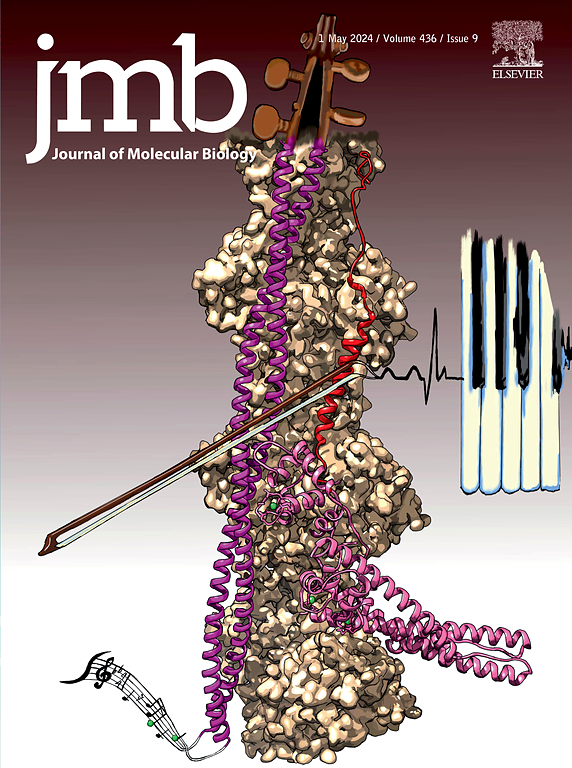Cryo-EM Observation of AA Amyloid Fibrils in Mouse Model of Systemic AApoAII Amyloidosis
IF 4.5
2区 生物学
Q1 BIOCHEMISTRY & MOLECULAR BIOLOGY
引用次数: 0
Abstract
The co-deposition of amyloid fibrils from different precursor proteins is a topic of increasing relevance for protein misfolding diseases. Using cryo-electron microscopy (cryo-EM), we here determined the structures of two serum amyloid A (SAA) protein-derived amyloid fibril morphologies that were extracted from a mouse strain that is primarily known to be associated with apolipoprotein A-II-derived amyloid fibrils. The two fibril morphologies show the same protomer conformation as in previously reported ex vivo amyloid fibrils from SAA protein but a different relative arrangement of fibril protein stacks. These data establish that serum amyloid A-derived amyloid fibrils share the same fibril protein fold in different mouse strains and disease contexts.

小鼠系统性AApoAII淀粉样变模型AA淀粉样原纤维的低温电镜观察。
来自不同前体蛋白的淀粉样蛋白原纤维的共同沉积是与蛋白质错误折叠疾病日益相关的主题。使用冷冻电镜(cro - em),我们在这里确定了从小鼠品系中提取的两种血清淀粉样蛋白A (SAA)蛋白衍生的淀粉样蛋白原纤维形态的结构,该品系主要已知与载脂蛋白A- ii衍生的淀粉样蛋白原纤维相关。这两种纤维形态显示出与先前报道的SAA蛋白的离体淀粉样原纤维相同的原蛋白构象,但纤维蛋白堆叠的相对排列不同。这些数据证实,血清淀粉样蛋白a衍生的淀粉样蛋白原纤维在不同的小鼠品系和疾病背景下具有相同的原纤维蛋白折叠。
本文章由计算机程序翻译,如有差异,请以英文原文为准。
求助全文
约1分钟内获得全文
求助全文
来源期刊

Journal of Molecular Biology
生物-生化与分子生物学
CiteScore
11.30
自引率
1.80%
发文量
412
审稿时长
28 days
期刊介绍:
Journal of Molecular Biology (JMB) provides high quality, comprehensive and broad coverage in all areas of molecular biology. The journal publishes original scientific research papers that provide mechanistic and functional insights and report a significant advance to the field. The journal encourages the submission of multidisciplinary studies that use complementary experimental and computational approaches to address challenging biological questions.
Research areas include but are not limited to: Biomolecular interactions, signaling networks, systems biology; Cell cycle, cell growth, cell differentiation; Cell death, autophagy; Cell signaling and regulation; Chemical biology; Computational biology, in combination with experimental studies; DNA replication, repair, and recombination; Development, regenerative biology, mechanistic and functional studies of stem cells; Epigenetics, chromatin structure and function; Gene expression; Membrane processes, cell surface proteins and cell-cell interactions; Methodological advances, both experimental and theoretical, including databases; Microbiology, virology, and interactions with the host or environment; Microbiota mechanistic and functional studies; Nuclear organization; Post-translational modifications, proteomics; Processing and function of biologically important macromolecules and complexes; Molecular basis of disease; RNA processing, structure and functions of non-coding RNAs, transcription; Sorting, spatiotemporal organization, trafficking; Structural biology; Synthetic biology; Translation, protein folding, chaperones, protein degradation and quality control.
 求助内容:
求助内容: 应助结果提醒方式:
应助结果提醒方式:


